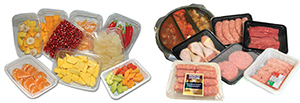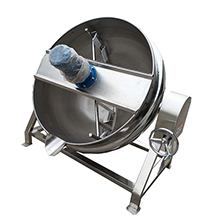The quality and shelf life of many foods have been improved due to packaging that maintains an atmosphere in the package headspace that is different from air (Ooraikul and Stiles, 1991; Smith et al., 1992; Riquelme et al., 1994; Perdue, 1997; Zagory, 1997; Blakistone, 1999; Ahvenainen, 2003a; Brody, 2003a; Mullan and McDowell, 2003; Robertson, 2006m). The modified atmospherecompliments refrigeration to retard chemical and/or microbiological deterioration of the food. In the case of fresh meat and poultry, fresh pasta and baked products, and fresh-prepared foods, plastic films that are good gas barriers maintain the atmosphere provided at the time of packaging.
For fresh fruits and vegetables, the appropriate plastic film in combination with the respiring product creates and then maintains the desired levels of oxygen and carbon dioxide. In some cases, active packaging concepts such as oxygen absorbers, carbon dioxide absorbers, and/or moisture regulators work with the packaging film to maintain the desired atmosphere.
The shelf life of red meat can be extended by packaging in a vacuum, so that oxidation reactions and growth of aerobic bacteria such as malodorous Pseudomonas bacteria are inhibited. Vacuum packaging of poultry is difficult because of the irregular shapes and sharp edges. Packaging atmospheres of nitrogen and 20 to 30% carbon dioxide are used to retard oxidation and microbial growth in both red meat and poultry. Packaging of red meat in atmospheres of 40 to 80% oxygen and 20 to 30% carbon dioxide provides desirable red color and microbial inhibition, but with increased rates of oxidative rancidity.
Fresh pasta and baked products are also vulnerable to oxidative rancidity and microbial degradation, especially mold growth. Vacuum packaging can inhibit both, but package headspace atmospheres of 50 to 100% carbon dioxide and 0 to 50% nitrogen are more common.
Chilled, prepared foods such as pasta, pizza, precooked meats and complete dishes are increasingly packaged in a modified atmosphere with no oxygen and >25% carbon dioxide, with the remainder nitrogen. Quality and shelf life are enhanced due to reduction of oxidation and inhibition of aerobic microorganisms. A separate category of chilled, prepared foods is Sous Vide. Preparation starts with vacuum packaging of the food in a flexible barrier-film package, followed by cooking in a hot water bath, moist steam, or pressure cooker. The cooked food is then rapidly cooled and then refrigerated. The combination of cooking under vacuum and then rapid cooling achieves higher quality and longer shelf life.
Packaging many fresh-whole and fresh-cut fruits and vegetables in a modified atmosphere with selected low oxygen content and elevated carbon dioxide content reduces respiration, with resulting increase in shelf life. An example is the 5 to 9% oxygen and 1 to 5% carbon dioxide atmosphere that is beneficial to oranges (Singh and Mannapperuma, 2000). MAP design for fruits and vegetables requires selection of a plastic film with proper oxygen permeability (Po), carbon dioxide permeability (Pc) and ratio between permeabilities (Pc/Po) that will give the desired atmosphere. The design must take into account the desired weight of product (W) and achieve the targeted atmosphere with a film of reasonable thickness and sealed package of reasonable surface area.


